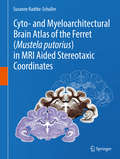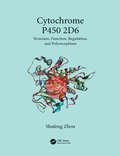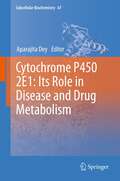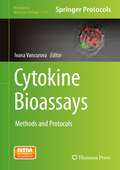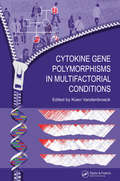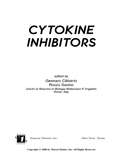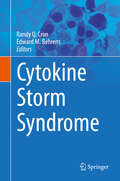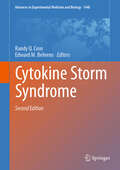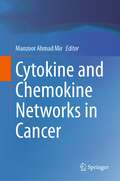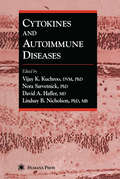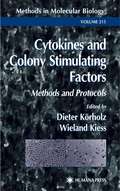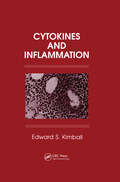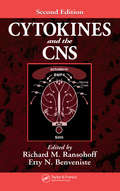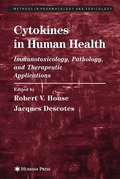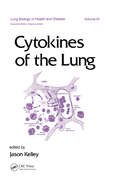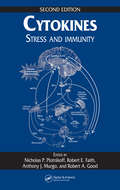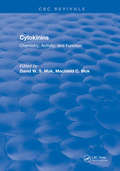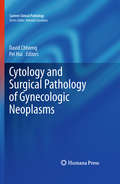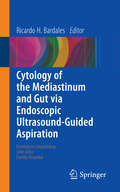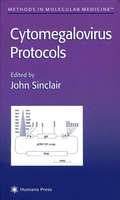- Table View
- List View
Cyto- and Myeloarchitectural Brain Atlas of the Ferret (Mustela putorius) in MRI Aided Stereotaxic Coordinates
by Susanne Radtke-SchullerDescriptionThis stereotaxic atlas of the ferret brain provides detailed architectonic subdivisions of the cortical and subcortical areas in the ferret brain using high-quality histological material stained for cells and myelin together with in vivo magnetic resonance (MR) images of the same animal. The skull-related position of the ferret brain was established according to in vivo MRI and additional CT measurements of the skull. Functional denotations from published physiology and connectivity studies are mapped onto the atlas sections and onto the brain surface, together with the architectonic subdivisions. High-resolution MR images are provided at levels of the corresponding histology atlas plates with labels of the respective brain structures. The book is the first atlas of the ferret brain and the most detailed brain atlas of a carnivore available to date. It provides a common reference base to collect and compare data from any kind of research in the ferret brain.Key Features Provides the first ferret brain atlas with detailed delineations of cortical and subcortical areas in frontal plane. Provides the most detailed brain atlas of a carnivore to date. Presents a stereotaxic atlas coordinate system derived from high-quality histological material and in vivo magnetic resonance (MR) images of the same animal. Covers the ferret brain from forebrain to spinal cord at intervals of 0.6 mm on 58 anterior-posterior levels with 5 plates each. Presents cell (Nissl) stained frontal sections (plate 1) and myelin stained sections (plate 2) in a stereotaxic frame. Provides detailed delineations of brain structures and their denomination on a Nissl stained background on a separate plate (3). Compiles abbreviations on plate 4, a plate that also displays the low resolution MRI of the atlas brain with the outlines of the Nissl sections in overlay. Displays high-resolution MR images at intervals of 0.15 mm from another animal with labeled brain structures as plate 5 corresponding to the anterior-posterior level of each atlas plate. Provides detailed references used for delineation of brain areas. Target audience of the book: The book addresses researchers and students in neurosciences who are interested in brain anatomy in general (e.g., for translational purposes/comparative aspects), particularly those who study the ferret as important animal model of growing interest in neurosciences.
Cytochrome P450 2D6: Structure, Function, Regulation and Polymorphism
by Shufeng ZhouCytochromes are proteins that catalyze electron transfer reactions of well-known metabolic pathways and are classified in various superfamilies. The CYP, or P450, superfamily accounts for 90% of the oxidative metabolism of clinical drugs. One member of this superfamily, P450 2D6 (or CYP2D6), singlehandedly metabolizes about 25% of all medications in the human liver. Cytochrome P450 2D6: Structure, Function, Regulation, and Polymorphism reviews the current knowledge of CYP2D6 as well as the maturing body of evidence indicating its significance to clinical and pharmacological researchers and practitioners. This book focuses on the critical role CYP2D6 plays in the human liver. It examines the genetic, epigenetic, physiological, pathological, and structural factors of the gene that govern the highly variable metabolism of a number of drugs in clinical use. It highlights the impact of the functional roles of CYP2D6 on clinical practice and drug development and also discusses implications for precise medicine, strategies to avoid adverse drug reactions, and paths for future research. Cytochrome P450 2D6 is a unique, valuable book focusing on a single but immensely powerful human gene. It provides the first single source of comprehensive information on CYP2D6 that serves as an important reference for medical, biomedical, pharmaceutical, and nursing researchers, practitioners, and students.
Cytochrome P450 2E1: Its Role In Disease And Drug Metabolism (Subcellular Biochemistry #67)
by Aparajita DeyThe book deals with various clinical aspects of cytochrome P450 2E1 (CYP2E1) which is a potent source for oxidative stress. Oxidative stress is critical for pathogenesis of diseases and CYP2E1 is a major contributor for oxidative stress. Several clinical disorders are associated with changes in regulation of CYP2E1 and the consequent abnormalities which include alcoholic liver disease, alcoholic pancreatitis, carcinogenesis, non-alcoholic fatty liver disease, non-alcoholic steatohepatitis, obesity, hepatitis C virus infection, reproductive organ toxicity, hepatocellular and cholestatic liver cirrhosis, inhibition of bone repair, cross-tolerance in smokers and people treated with nicotine, disorders of central nervous system, changes in metabolism of protoxicants in the circulatory system and susceptibility to human papillomavirus infection. Hence, CYP2E1 emerges as a new and potent player in aggravating injury and furthering disease complications.
Cytochrome P450: In Vitro Methods and Protocols (Methods in Pharmacology and Toxicology)
by Gary W. Caldwell Zhengyin YanThis collection explores detailed experimental protocols necessary for setting up a variety of in vitro cytochrome P450 (CYP) assays that are vital in selecting drug candidates in a drug discovery pipeline. Major factors affecting drug metabolism include CYP expression levels, kinetic parameters for individual CYP enzymes, CYP inhibition and induction, time-dependent inhibition (TDI), CYP stability, non-CYP stability, UDP-glucuronosyltransferases (UGT) stability, excretion mechanisms, and drug-drug interactions (DDI), all addressed in this volume. Written for the Methods in Pharmacology and Toxicology series, chapters include helpful background information on the in vitro assay, a list of all the materials, reagents, and equipment necessary to carry out the assay, a step-by-step protocol, notes containing common and unexpected experimental problems in the assay, as well as references containing important supplementary reading. Authoritative and practical, Cytochrome P450: In Vitro Methods and Protocols serves as a key guide for researchers in the area of discovery and development of new medicines.
Cytogenetics, FISH and Molecular Testing in Hematologic Malignancies
by Wojciech GorczycaCytogenetics, fluorescence in situ hybridization (FISH) and molecular tests, especially polymerase chain reaction (PCR), play an important role in the management of patients with hematologic malignancies by helping to establish the diagnosis, as well as predict prognosis, response to treatment and disease progression. Chromosomal and molecular abno
Cytohistology of Small Tissue Samples
by Lester J. Layfield Carlos W. Bedrossian Julia R. Crim Lucio PalombiniEach volume in this richly illustrated series, sponsored by the Papanicolaou Society of Cytopathology, provides an organ-based approach to the cytological and histological diagnosis of small tissue samples. Benign, pre-malignant and malignant entities are presented in a well-organized and standardized format, with high-resolution color photomicrographs, tables, tabulated specific morphologic criteria and appropriate ancillary testing algorithms. Example vignettes allow the reader to assimilate the diagnostic principles in a case-based format. This volume describes the cytologic, small core biopsy, immunohistochemical and molecular diagnostic features of musculoskeletal lesions. It provides the cytopathologist and histopathologist with a comprehensive survey of diagnostic approaches and diagnostic features for benign and malignant lesions. Each chapter contains a detailed summary of differential diagnostic features, supported by high-quality images and case studies. The print edition includes a CD-ROM offering all images in a downloadable format. With over 500 photomicrographs, this is an important resource for practising pathologists and residents in pathology.
Cytohistology of Small Tissue samples
by Aileen Wee Pichet Sampatanukul Nirag Jhala Aileen Wee Pichet SampatanukulEach volume in this richly illustrated series, published in association with the Papanicolaou Society of Cytopathology, provides an organ-based approach to the cytologic and histologic diagnosis of small tissue samples. Benign, pre-malignant and malignant entities are presented in a well-organized and standardized format, with high-resolution color photomicrographs, tables, and lists of key specific morphologic criteria. Example vignettes allow the reader to assimilate the diagnostic principles in a case-based format. This volume provides comprehensive coverage of both surgical pathology and cytopathology of focal liver lesions. Extensively illustrated throughout, it contains key cytologic and histologic features, practical points, radiologic and morphologic pictures, flow charts, and tabulated summaries for easy comprehensive overview and quick reference and provides a pragmatic algorithmic approach to cytohistologic diagnosis. With over 700 printed photomicrographs and a CD-ROM offering all images in a downloadable format, this is an important resource for all anatomic pathologists.
Cytokine Bioassays: Methods and Protocols (Methods in Molecular Biology #1172)
by Ivana VancurovaCytokines are pleiotropic regulatory proteins involved in essentially all biological processes and associated with a wide variety of diseases, including inflammatory disorders as well as many types of cancer and leukemia. Knowledge about the quantitative and qualitative nature of cytokine production is critical in the understanding of normal and pathological processes. The cytokine detection in biological and clinical samples faces many challenges including their low abundance, the need to distinguish between active and latent cytokine forms, and the need to measure multiple cytokines in a single assay. This volume will provide a comprehensive collection of classic and cutting-edge methodologies that are currently used to analyze and quantify cytokines and their biological activities in complex biological and clinical samples. The chapters are divided into four main categories. The first group focuses on the immunodetection of released cytokines in tissue culture supernatants, plasma, serum and whole blood samples by immunoassays. These immunoassays measure the total concentrations of released cytokines regardless of their biological activity and include ELISA, flow cytometry, ELISPOT and the antibody-based proximity ligation The second group will focus on the analysis of biologically active cytokines by bioassays using neutralizing antibodies, chemotaxis assay, cytokine-induced cell degranulation assay, cell proliferation and differentiation, cytokine-induced cytokine production and the radioreceptor cytokine assay. The third group focuses on the analysis of intracellular cytokines by flow cytometry, western blotting and fluorescence and confocal microscopy. In addition, this category includes protocols for quantitative analysis of cytokine gene expression by real time RT-PCR and analysis of the cytokine promoter occupancy by chromatin immunoprecipitation. The fourth group focuses on the recently developed multiplex arrays that can measure multiple cytokines in the same sample at the same time. This group includes quantification of multiple cytokines using cytometric bead arrays, ELISPOT assays, proteomics cytokine evaluation, multiplexed proximity ligation assays for high-throughput cytokine analysis and finally, cytokine gene expression analysis by gene arrays. The protocols will be written by experienced basic and clinical researchers with hands-on knowledge of the described protocols. By covering a broad variety of methods used in cytokine detection and analysis, this book will be of interest not only to biochemists, molecular biologists and immunologists but also to physician-scientists working in the field of cytokine research.
Cytokine Frontiers: Regulation of Immune Responses in Health and Disease
by Takayuki Yoshimoto Tomohiro YoshimotoThis book guides the reader through the latest research on the cytokine network, covering signaling pathways, control of the immune response, and potential therapeutics. Different cytokines stimulate diverse responses in various phases of inflammation and immunity, including the innate immune response, the generation of effector T cells, and the development of antibodies by the humoral immune system. It is now clear that the pathophysiology of many infectious, autoimmune, allergic, and malignant diseases can be largely explained by which cytokines are induced and subsequently regulate the cellular responses. In clinical medicine, cytokines are involved in a wide spectrum of diseases. This book describes in three parts the properties and roles of 15 key cytokines under physiological and pathological conditions. Part I presents nine cytokines associated with inflammatory disorders, pro-inflammatory cytokines, and the recently identified new helper T (Th) subset: Th17 cells. Part II gives details of three cytokines associated with allergic disorders, including Th2 responses and recently identified types of innate cells. Part III describes three cytokines that are associated with immunological tolerance and anti-inflammation, including regulatory T (Treg) cells, IL-10-producing Treg (Tr1) cells, and inducible IL-35-producing Treg (iTr35) cells. Cytokines are considered to be important as therapeutic targets for specific agonists or antagonists in numerous immune and inflammatory diseases. The ultimate goal of this book is to facilitate the development of therapeutic treatments for such diseases which has been limited by an insufficient understanding of the biology of cytokines and the complicated network that they create.
Cytokine Gene Polymorphisms in Multifactorial Conditions
by Koen VandenbroeckThe literature on cytokine genetics is vast, so vast that it is now practically beyond the time or logistical constraints of most scientists to successfully keep pace with it. A compilation of the latest research, Cytokine Gene Polymorphisms in Multifactorial Conditions brings together, reviews, and structures up-to-date information on polymorphism
Cytokine Inhibitors
by Gennaro Ciliberto Rocco SavinoCompiling an up-to-date and detailed survey of the role cytokines play in cell-to-cell communication, development, and differentiation, this comprehensive reference highlights the medical advantages of cytokine inhibition and pursues novel methods of discovery for more potent and specific blocking agents. Investigates the pathogenic role of
Cytokine Storm Syndrome
by Randy Q. Cron Edward M. BehrensCytokine Storm Syndromes, including HLH and MAS, are frequently fatal disorders, particularly if not recognized early and treated during presentation. The genetics of Cytokine Storm Syndromes are being defined with many of the risk alleles giving rise to mutations in the perforin-mediated cytolytic pathway used by CD8 cytotoxic T cells and natural killer cells. These are being studied using murine models. Up to 10% of the general population may carry risk alleles for developing Cytokine Storm Syndromes, and Cytokine Storm Syndromes are being increasingly recognized around the world in pediatric and adult hospitals.A variety of infectious, rheumatic, and oncologic triggers are commonly associated with Cytokine Storm Syndromes, but understanding this disorder is critical for all researchers and physicians to ensure timely and appropriate therapy. This textbook, the first of its kind, addresses all aspects of the disorder – from genetics, pathophysiology, and ongoing research, to clinical presentations, risk factors, and treatment.
Cytokine Storm Syndrome (Advances in Experimental Medicine and Biology #1448)
by Randy Q. Cron Edward M. BehrensCytokine Storm Syndromes, including HLH and MAS, are frequently fatal disorders, particularly if not recognized early and treated during presentation. The genetics of Cytokine Storm Syndromes are being defined with many of the risk alleles giving rise to mutations in the perforin-mediated cytolytic pathway used by CD8 cytotoxic T cells and natural killer cells. These are being studied using murine models. Up to 10% of the general population may carry risk alleles for developing Cytokine Storm Syndromes, and Cytokine Storm Syndromes are being increasingly recognized around the world in pediatric and adult hospitals. A variety of infectious, rheumatic, and oncologic triggers are commonly associated with Cytokine Storm Syndromes, but understanding this disorder is critical for all researchers and physicians to ensure timely and appropriate therapy. This second edition addresses all aspects of the disorder, from genetics, pathophysiology, and ongoing research, to clinical presentations, risk factors and treatment. New-to-this-edition features include dedicated chapters on severe COVID-19 CSS, and post-COVID CSS of multi-system inflammatory syndrome in children (MIS-C). In addition, novel topics including CSS associated with Castleman disease, pregnancy, therapeutics, transplantation, and cardiac bypass, as well as treatment with JAK inhibitors are addressed.
Cytokine and Chemokine Networks in Cancer
by Manzoor Ahmad MirCytokine and Chemokine Networks in Cancer" provides a comprehensive exploration of the roles of cytokines and chemokines in cancer biology. It offers valuable insights into their diagnostic, prognostic, and therapeutic implications, making it a valuable resource for researchers, clinicians, and students interested in the field of cancer immunology and therapy. This book illustrates the importance and significance of the cytokine and chemokine signaling networks in tumor development and progression. It describes the complex networks mediated by cytokine and chemokine receptors promoting tumor cell proliferation, site-directed metastasis, and activation of angiogenic switch in tumor cells. The books also shed light on the heterogeneity of cytokines and chemokine in solid malignancies and their impact on tumor progression and therapeutic outcomes. The chapters provide current information about the types of cytokine-chemokine interactions in promoting cancer stem cell-like characteristics, epithelial to mesenchymal transition, and modulation of the tumor microenvironment. The significance of the complex interactions in cancer biology in the light of therapeutic resistance is also highlighted. The chapters also describe recent advancements in the therapeutic potential of targeting the pro-tumor cytokine and chemokine networks and limiting tumor cell metastasis. Finally, the book also provides a comprehensive yet representative description of a large number of challenges associated with targeting these vital chemokine-cytokine networks. Given its content, the book provides valuable information for researchers in the field of cancer biology and molecular medicine.
Cytokines and Autoimmune Diseases
by Nora Sarvetnick Lindsay B. Nicholson David A. Hafler Vijay K. KuchrooLeading researchers synthesize scattered experimental data to help develop an intimate understanding of how cytokines and chemokines are involved in the pathogenesis of autoimmune diseases. The many chapters offer critical reviews the basic mechanisms controlling cytokine induction and regulation, as well as the resulting production of proinflammatory and anti-inflammatory cytokines, the former of which induces organ-specific autoimmune diseases. From the vantage of these insights, they address the role of cytokines in a wide variety of autoimmune diseases, uvetis, encephalomyelitis, multiple sclerosis, human type 1 diabetes, rheumatoid arthritis, SLE, and myasthenia gravis. Authoritative and state-of-the-art, Cytokines and Autoimmune Disease highlights the enormous therapeutic potential of cytokine modulation in the treatment of autoimmune disease.
Cytokines and Colony Stimulating Factors: Methods and Protocols (Methods in Molecular Biology #215)
by Wieland Kiess Dieter KörholzHands-on laboratory experts describe for the novice investigator a host of novel technologies and molecular techniques specifically designed to study cellular immunology and promote its gene therapy applications. Presented in step-by-step detail to ensure ready reproducibility, these protocols range from flow cytometric techniques to detect cytokines and growth factors in different specimens, to methods for generating and expanding dendritic cells and hematopoietic progenitors from different origins. Although the protocols require little previous experience, even highly skilled researchers will augment their skills with many novel timesaving techniques.
Cytokines and Inflammation
by Edward S. KimballThis important new book focuses on the involvement of cytokines in specific areas of inflammatory diseases, such as granulomatous responses, lung disease, hepatic dysfunction and the acute phase, arthritis and accompanying bone remodeling, neurogenic inflammation, and shock. The roles of GM-CSF, IL-6, IL-2, TGFb EGF, and LIF are discussed, as well as the medical treatments that affect cytokine activity. The results of approaches important to the biotechnology and pharmaceutical industries, such as the search for endogenous biological response modifiers that control cytokine function or production, attempts to synthesize heterocyclic compounds in the organic chemistry lab, and research regarding second messenger pathways involved in IL-1 and TNF production are examined. This book will provide anyone in cytokine research, especially clinical investigators, pharmaceutical industry researchers, and academic research scientists, with important information on how cytokine research might be used.
Cytokines and the CNS
by Richard M. Ransohoff Etty N. BenvenisteProvides Insight into How Cytokine Action Impacts the Physiology and Pathology of the CNS.As with the first edition of Cytokines and the CNS, this completely updated and revised edition introduces neurobiologists to cytokine biology and immunologists to the unique functions of cytokines in CNS physiology. The dramatically accelera
Cytokines in Human Health: Immunotoxicology, Pathology, and Therapeutic Applications (Methods in Pharmacology and Toxicology)
by Jacques Descotes Robert V. HouseThis comprehensive book explores the role of cytokines in immunotoxicology and human health using a variety of complex methods, from basic research to highly applied therapeutic applications. It includes a basic study of cytokines and details the effects of cytokines on the immune system and in treating cancer. The book serves as both a primer and a starting point for a more detailed investigation of the role these biological regulators play.
Cytokines of the Lung
by J. KelleyFocusing on all the major cytokine families, this reference book provides coverage of cytokine regulatory processes in the lung and other tissues and comprehensive descriptions of cytokine functions specific to the lung.;Discussing the diverse cytokine-binding proteins and the role of cytokines in tissue injury and repair processes and extracellular matrix regulations, the book supplies information on amino acid structure and gene regulatory sequences, examines the receptor biology of individual cytokines, illustrates cytokine interactions with their cognate receptors and surveys the phenotypic effects of individual cytokines on target cells. With over 2700 literature citations and figures, this book is a resource for pulmonologists, physiologists, immunologists, cell and molecular biologists, environmental toxicologists, oncologists, and graduate-level and medical school students in these disciplines.
Cytokines: Stress and Immunity, Second Edition
by Tania Sih Peter A. R. ClementCytokine involvement in the immune system's response to stress is now very well documented. Cytokine activity has been implicated in a variety of mental and physical diseases, and has been shown to have a significant role in fueling the vicious circle of depression and illness.The first edition of Cytokines: Stress and Immunity pointed out
Cytokinins: Chemistry, Activity, and Function
by David W. MokCytokinins are hormones involved in all aspects of plant growth and development and are essential for in vitro manipulation of plant cells and tissues. Much information has been gathered regarding the chemistry and biology of cytokinins, while recent studies have focused on the genetics and cytokinin-related genes. However, other than proceedings of symposia, no single volume on cytokinins has been written. This book is the first of its kind, homing in on the key subject areas of cytokinin-chemistry, biosynthesis, metabolism, activity, function, genetics, and analyses. These areas are comprehensively reviewed in individual chapters by experts currently active in the field. In addition, a personal history on the discovery of cytokinin is presented by Professor Folke Skoog. This volume summarizes previous findings and identifies future research directions.
Cytology and Surgical Pathology of Gynecologic Neoplasms (Current Clinical Pathology)
by Pei Hui David ChhiengThe neoplasms found in the female genital tract are numerous and growing more complex. Cytology and Surgical Pathology of Gynecologic Neoplasms has been written to provide a practical reference for practicing pathologists and cytopathologists in a quick and concise fashion. The primary focus of this book is on gynecological tumors, specifically common ones and their benign mimics. Emphasis is placed on morphologic recognition, resolving common diagnostic problems seen in routine practices, and discussion of current classification of gynecologic malignancies. Special references to the differential diagnosis and pitfalls of each entity are included. The role of cytology and its correlation with histology is richly illustrated and discussed. Also presented is the practical use of ancillary studies such as molecular diagnostic testing and immunohistochemistry. With a unique emphasis on the correlation between cytology and surgical pathology, Cytology and Surgical Pathology of Gynecologic Neoplasms provides a ready reference for both the practicing pathologist and pathologist in training in finding quick answers to their diagnostic challenges.
Cytology of the Mediastinum and Gut Via Endoscopic Ultrasound-Guided Aspiration (Essentials in Cytopathology #25)
by Ricardo H. BardalesThis text provides a comprehensive review of the cytology of disease processes of the mediastinum and mediastinal lymph nodes with emphasis in lung and gut nodal cancer staging in specimens obtained by EUS-FNA. This book also reviews the cytology of intramural masses of the gastrointestinal tract using a pattern-based diagnostic approach. The cytomorphology of lesions obtained by EUS-FNA is peculiar by the common presence in the obtained sample of normal luminal gastrointestinal contents, and the cytopathologist should be familiar with this pattern not often seen when the sampling is done by percutaneous approach. Technical considerations pertaining to the operator performing the procedure as well as to the cytopathologist, with emphasis on rapid on-site interpretation are also covered. Most lesions described in the book also have endoscopic US image correlation. Cytology of the Mediastinum and Gut is a useful and practical guide for cytological interpretation and differential diagnosis of lesions obtained by EUS-FNA of mediastinum and gut. All chapters are written by experts with many years of experience in the field and contain the cytology, immuno-profile, molecular profile, and ultrasound features of the masses described.
Cytomegalovirus Protocols (Methods in Molecular Medicine #33)
by John SinclairJohn Sinclair and a panel of expert investigators present a comprehensive collection of cellular and molecular techniques for the analysis of cytomegalovirus (CMV) biology and its pathogenetic mechanisms. The methods-all described in step-by-step detail with ready reproducibility in mind-range from basic virus culture to complex molecular analysis of CMV structure and function. Included are methods for CMV detection using both immunological and biological techniques, methods for analyzing fundamental aspects of the CMV infection cycle, and methods for analyzing T cell response to cytomegalovirus infection in the human host. Comprehensive and state-of-the-art, Cytomegalovirus Protocols provides investigators with a collection of the key methods that are illuminating not only the basic biology of this complex and intriguing human herpesvirus, but also its significant role in human infectious diseases and their emergent therapies.
